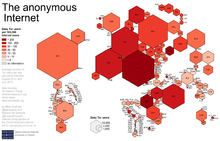Darknet
A darknet (or dark net) is an overlay network that can only be accessed with specific software, configurations, or authorization, often using non-standard communications protocols and ports. Two typical darknet types are friend-to-friend[1] networks (usually used for file sharing with a peer-to-peer connection)[2] and privacy networks such as Tor.
The reciprocal term for an encrypted darknet is clearnet[3][4][5] or surface web when referring to search engine indexable content.[6]
Terminology
As of 2015, "The Darknet" is often used interchangeably with the dark web due to the quantity of hidden services on Tor's darknet. The term is often used inaccurately and interchangeably with the deep web due to Tor's history as a platform that could not be search indexed. Mixing uses of both of these terms has been described as inaccurate,[7] with some commentators recommending the terms be used in distinct fashions.[8][9]
Origins
Originally coined in the 1970s to designate networks which were isolated from ARPANET (which evolved into the Internet) for security purposes,[10] darknets were able to receive data from ARPANET but had addresses which did not appear in the network lists and would not answer pings or other inquiries.
The term gained public acceptance following publication of "The Darknet and the Future of Content Distribution",[11] a 2002 paper by Peter Biddle, Paul England, Marcus Peinado, and Bryan Willman, four employees of Microsoft who argued that the presence of the darknet was the primary hindrance to the development of workable DRM technologies and inevitability of copyright infringement.
Sub-cultures
Journalist J. D. Lasica in his 2005 book Darknet: Hollywood's War Against the Digital Generation describes the darknet's reach encompassing file sharing networks.[12] Consequently, in 2014, journalist Jamie Bartlett in his book The Dark Net would use it as a term to describe a range of underground and emergent sub cultures, including
- Camgirls
- Cryptoanarchists
- Darknet drug markets
- Self Harm communities
- Social media racists
- Transhumanists.[13]
Uses
Darknets in general may be used for various reasons, such as:
- Computer crime (hacking, file corruption etc.)
- Protecting dissidents from political reprisal
- File sharing (warez, personal files, pornography, confidential files, illegal or counterfeit software etc.)
- To better protect the privacy rights of citizens from targeted and mass surveillance
- Sale of restricted goods on darknet markets
- Whistleblowing and news leaks
Software
All darknets require specific software installed or network configurations made to access them, such as Tor which can be accessed via a customised browser from Vidalia, aka the Tor browser bundle or alternatively via a proxy server configured to perform the same function.
Active

- Decentralized network 42 (not for anonymity but research purposes)
- Freenet is a popular darknet (friend-to-friend) by default; since version 0.7 it can run as a "opennet" (peer nodes are discovered automatically).
- GNUnet is a darknet if the "F2F (network) topology" option is enabled.
- I2P (Invisible Internet Project) is another overlay network that features a darknet whose sites are called "Eepsites".
- OneSwarm can be run as a darknet for friend-to-friend file-sharing.
- RetroShare can be run as a darknet (friend-to-friend) by default to perform anonymous file transfers if DHT and Discovery features are disabled.
- Riffle is a client-server darknet system that simultaneously provides secure anonymity (as long as at least one server remains uncompromised), efficient computation, and minimal bandwidth burden.[14][15]
- RShare (discontinued)
- StealthNet (discontinued)
- Syndie is software used to publish distributed forums over the anonymous networks of I2P, Tor and Freenet.
- Tor (The onion router) is an anonymity network that also features a darknet - its "hidden services". It is the most popular instance of a darknet.[16]
- Tribler can be run as a darknet for file-sharing.
- Zeronet is open source software aimed to build an internet-like computer network of peer-to-peer users of Tor.
Defunct
See also
References
- ↑ Wood, Jessica (2010). "The Darknet: A Digital Copyright Revolution" (PDF). Richmond Journal of Law and Technology. 16 (4): 15–17. Retrieved 25 October 2011.
- ↑ Mansfield-Devine, Steve (December 2009). "Darknets". Computer Fraud & Security. 2009 (12): 4–6. doi:10.1016/S1361-3723(09)70150-2.
- ↑ Miller, Tessa (10 January 2014). "How Can I Stay Anonymous with Tor?". Life Hacker. Retrieved 7 June 2015.
- ↑ Torpey, Kyle (2 December 2014). "Blockchain.info Launches Tor Hidden Service". Inside Bitcoins. Retrieved 9 June 2015.
- ↑ Roger, Jolly. "Clearnet vs Hidden Services—Why You Should Be Careful". Jolly Roger’s Security Guide for Beginners. DeepDotWeb. Retrieved 4 June 2015.
- ↑ Barratt, Monica (15 January 2015). "A Discussion About Dark Net Terminology". Drugs, Internet, Society. Retrieved 14 June 2015.
- ↑ "Clearing Up Confusion – Deep Web vs. Dark Web". BrightPlanet.
- ↑ NPR Staff (25 May 2014). "Going Dark: The Internet Behind The Internet". Retrieved 29 May 2015.
- ↑ Greenberg, Andy (19 November 2014). "Hacker Lexicon: What Is the Dark Web?". Retrieved 6 June 2015.
- ↑ "Om Darknet". Archived from the original on 25 March 2015. Retrieved 11 March 2012.
- ↑ Biddle, Peter; England, Paul; Peinado, Marcus; Willman, Bryan (18 November 2002). The Darknet and the Future of Content Distribution (PDF). ACM Workshop on Digital Rights Management. Washington, D.C.: Microsoft Corporation. Retrieved 10 October 2012.
- ↑ Lasica, J. D. (2005). Darknets: Hollywood's War Against the Digital Generation. Hoboken, NJ: J. Wiley & Sons. ISBN 0-471-68334-5.
- ↑ Ian, Burrell (28 August 2014). "The Dark Net:Inside the Digital Underworld by Jamie Bartlett, book review". Retrieved 3 June 2015.
- ↑ Young Hyun Kwon (20 May 2015). "Riffle: An Efficient Communication System with Strong Anonymity" (PDF). Retrieved 12 July 2016.
- ↑ Larry Hardesty, MIT News Office (11 July 2016). "How to stay anonymous online". Retrieved 12 July 2016.
- ↑ "Anticounterfeiting on the Dark Web - Distinctions between the Surface Web, Dark Web and Deep Web" (PDF). 13 April 2015. Retrieved 1 June 2015.
External links
- Boutin, Paul (January 28, 2004). "See You on the Darknet". Slate.
- "File-sharing 'darknet' unveiled". BBC News. August 16, 2006.
- Darknet 101 - introduction for non technical people